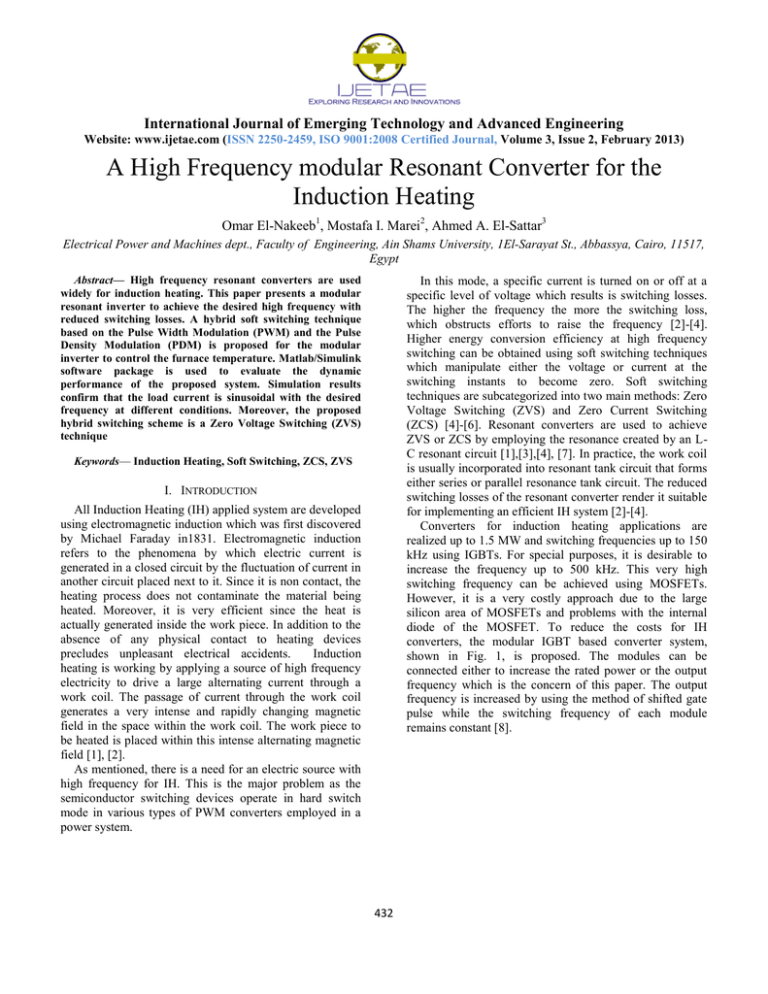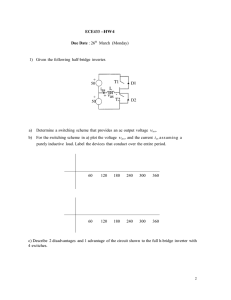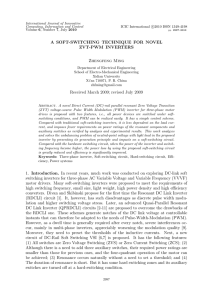
International Journal of Emerging Technology and Advanced Engineering
Website: www.ijetae.com (ISSN 2250-2459, ISO 9001:2008 Certified Journal, Volume 3, Issue 2, February 2013)
A High Frequency modular Resonant Converter for the
Induction Heating
Omar El-Nakeeb1, Mostafa I. Marei2, Ahmed A. El-Sattar3
Electrical Power and Machines dept., Faculty of Engineering, Ain Shams University, 1El-Sarayat St., Abbassya, Cairo, 11517,
Egypt
In this mode, a specific current is turned on or off at a
specific level of voltage which results is switching losses.
The higher the frequency the more the switching loss,
which obstructs efforts to raise the frequency [2]-[4].
Higher energy conversion efficiency at high frequency
switching can be obtained using soft switching techniques
which manipulate either the voltage or current at the
switching instants to become zero. Soft switching
techniques are subcategorized into two main methods: Zero
Voltage Switching (ZVS) and Zero Current Switching
(ZCS) [4]-[6]. Resonant converters are used to achieve
ZVS or ZCS by employing the resonance created by an LC resonant circuit [1],[3],[4], [7]. In practice, the work coil
is usually incorporated into resonant tank circuit that forms
either series or parallel resonance tank circuit. The reduced
switching losses of the resonant converter render it suitable
for implementing an efficient IH system [2]-[4].
Converters for induction heating applications are
realized up to 1.5 MW and switching frequencies up to 150
kHz using IGBTs. For special purposes, it is desirable to
increase the frequency up to 500 kHz. This very high
switching frequency can be achieved using MOSFETs.
However, it is a very costly approach due to the large
silicon area of MOSFETs and problems with the internal
diode of the MOSFET. To reduce the costs for IH
converters, the modular IGBT based converter system,
shown in Fig. 1, is proposed. The modules can be
connected either to increase the rated power or the output
frequency which is the concern of this paper. The output
frequency is increased by using the method of shifted gate
pulse while the switching frequency of each module
remains constant [8].
Abstract— High frequency resonant converters are used
widely for induction heating. This paper presents a modular
resonant inverter to achieve the desired high frequency with
reduced switching losses. A hybrid soft switching technique
based on the Pulse Width Modulation (PWM) and the Pulse
Density Modulation (PDM) is proposed for the modular
inverter to control the furnace temperature. Matlab/Simulink
software package is used to evaluate the dynamic
performance of the proposed system. Simulation results
confirm that the load current is sinusoidal with the desired
frequency at different conditions. Moreover, the proposed
hybrid switching scheme is a Zero Voltage Switching (ZVS)
technique
Keywords— Induction Heating, Soft Switching, ZCS, ZVS
I. INTRODUCTION
All Induction Heating (IH) applied system are developed
using electromagnetic induction which was first discovered
by Michael Faraday in1831. Electromagnetic induction
refers to the phenomena by which electric current is
generated in a closed circuit by the fluctuation of current in
another circuit placed next to it. Since it is non contact, the
heating process does not contaminate the material being
heated. Moreover, it is very efficient since the heat is
actually generated inside the work piece. In addition to the
absence of any physical contact to heating devices
precludes unpleasant electrical accidents.
Induction
heating is working by applying a source of high frequency
electricity to drive a large alternating current through a
work coil. The passage of current through the work coil
generates a very intense and rapidly changing magnetic
field in the space within the work coil. The work piece to
be heated is placed within this intense alternating magnetic
field [1], [2].
As mentioned, there is a need for an electric source with
high frequency for IH. This is the major problem as the
semiconductor switching devices operate in hard switch
mode in various types of PWM converters employed in a
power system.
432
International Journal of Emerging Technology and Advanced Engineering
Website: www.ijetae.com (ISSN 2250-2459, ISO 9001:2008 Certified Journal, Volume 3, Issue 2, February 2013)
There are three switching modes of the voltage source
series resonant PDM inverter. During the on time the
transistor are turned on and off in opposite pairs T1 with T4
and T2 with T3, such as modes I and II, to produce a square
wave voltage [9]-[12]. During the off time, mode III is used
to produce a zero voltage state at its output terminals.
When T4 is turned on, the loop is closed through D2 and
when T2 is turned on, the loop is closed through D4 [9],
[10].
Fig.1 Modular converter topology
It is often desirable to control the amount of power
processed by an induction heater to control the rate at
which heat energy is transferred to the work piece. Load
power regulation is important for high quality heating
system. Different control strategies have been proposed
such as frequency control and phase-shift control [9], [10].
However, with these techniques, switching losses and
electromagnetic noises appear because switching devices
are not always turned on and off at zero current or voltage
crossings. Another control strategy that overcomes the
aforementioned drawbacks is the Pulse Density Modulation
(PDM). Moreover, the PDM technique results in reducing
of the size of filtering capacitor [9].
Fig. 2 Series resonant inverter
Fig. 3 illustrates the principles of PDM based power
control. It presents a case of pulse density:
D=
Ton 3
=
T
4
Where T=N Tr = Ton +Toff. Tr is the periodic time of the
output current.
Square wave voltages are produced when the inverter is
in mode I and mode II every half resonant cycle, and
during a period Ton of three resonant cycles. The fourth
resonant cycle presents off period T off (mode III), and
therefore produces the zero voltage state to the resonant
circuit [9], [12]. Moreover, variable output voltage can be
obtained by varying the gain of the inverter, which is
normally accomplished by pulse-width-modulation (PWM)
control within the inverter. The inverter gain may be
defined as the ratio of the ac output voltage to dc input
voltage. There are various PWM techniques to vary the
inverter gain; however, the most efficient method for the
IH application that satisfy the constrains for applying soft
switching, is the single pulse width modulation.
II. PULSE DENSITY MODULATION (PDM)
The PDM is a control strategy that uses fixed firing
pattern. Typically, the voltage is applied to the load during
few cycles followed by an off time (zero voltage) [11].
Power regulation is ensured by adjusting the pulse number
during the on time [10]. The switching frequency Wc is
equal to the resonance frequency Wr of the load tank. The
power stage consists of an ac voltage source connected to a
single phase diode rectifier whose output is equal to the
double of the network frequency. A smoothing capacitor is
inserted at the output of the rectifier to filter the high
frequency components. A series resonant inverter using
four transistors T1 to T4, interconnected to the
freewheeling diodes D1 to D4, as shown in Fig. 2, is used
to create a high frequency current wave amplitude
modulated by the PDM control strategy [9], [12].
433
International Journal of Emerging Technology and Advanced Engineering
Website: www.ijetae.com (ISSN 2250-2459, ISO 9001:2008 Certified Journal, Volume 3, Issue 2, February 2013)
The difference between this two values represent the
error which is processed by a PID controller that determine
the proper value of duty cycle or the pulse width required
to achieve the set point. The second stage is the generation
of the gating signals using the proposed hybrid switching
technique shown in Fig. 6
Fig.3. the PDM technique
Fig.4 resonant converter for IH system
III. THE PROPOSE CONTROL SYSTEM FOR THE MODULAR
RESONANT CONVERTER BASED IH FURNACE
Power
High Frequency
Converter
The proposed system consists of a series resonant tank
where the induction furnace is represented by RL in series
with a capacitor and the proposed modular high frequency
converter to supply the required power to the resonant tank
from the 50Hz ac supply through a full bridge rectifier. The
modular type inverter is utilized with some modifications
to reduce the cost of the system. One modification is the
elimination of the summing high frequency power
transformer by connecting the modules in parallel and
directly to the resonant tank. Moreover, this arrangement
leads to reduce the freewheeling diodes to one set only
connected with both modules as shown in Fig. 4.
To control the work piece temperature, it had to control
the amount of power transferred to the furnace by
controlling the switching of the inverter switches. The
proposed control strategy regulates the heat of the IH
furnace utilizing the soft switching principle that is based
on the PWM and the PDM techniques [5], [6].
The control system consists of two stages as shown in
Fig. 5. In the first stage, the actual temperature of the work
piece is measured and compared with the desired
temperature.
Induction Furnace
Control System
Tact
Duty
Switching technique
Cycle
_
Error
PID
+
Cycle
Tref
Fig. 5 The proposed control system for the induction furnace
PDM
Enable
Signal
Duty
PWM
Cycle
Enable
Gate
Cycle
Fig. 6 The proposed switching technique
434
Switches
Signal
Signal
International Journal of Emerging Technology and Advanced Engineering
Website: www.ijetae.com (ISSN 2250-2459, ISO 9001:2008 Certified Journal, Volume 3, Issue 2, February 2013)
Fig. 7 The PWM controls.
The proposed hybrid switching technique is based on the
PWM and the PDM techniques. The output from the PID
controller is the duty cycle of the PWM control, shown in
Fig. 7, which varies from 0 to 0.5. If the duty cycle reaches
the minimum value (0.2) for a certain time (0.01s), the
controller decrements the switching signals by one signal
repeated each ten cycles. This process is repeated each time
the output of the PID reach its minimum value and stay on
it for a time delay.
On the other hand, if the duty cycle reaches the
maximum value (0.46) for a certain time, the controller
increments the switching signals by one signal repeated
each ten cycles. This process is repeated each time the
output of the PID reach its maximum or maximum value
and stay on it for a time delay. Fig. 8 portrays the block
diagram of the PDM control. Fig. 9 presented a hybrid
switching technique which results from merging the PWM
and PDM techniques.
Fig. 8 The PDM controls.
435
International Journal of Emerging Technology and Advanced Engineering
Website: www.ijetae.com (ISSN 2250-2459, ISO 9001:2008 Certified Journal, Volume 3, Issue 2, February 2013)
Fig. 9 Gate signal generation for the modular
Fig. 10 shows the switching signals for the two inverter
nodules. The switching signal frequency for any gate is 5
KHz which reflects the output frequency of any inverter
module. As discussed before, the output frequency of the
proposed modular inverter system is, 10 KHz, double that
of one module. In addition, it is obvious that any inverter
module is turned on for one cycle and turned-off for
another cycle. The switching of the two inverter modules is
interchangeable as expected.
IV. SIMULATION RESULTS
The proposed induction heating system including the
high frequency converter, IH furnace and the controller is
simulated using Matlab/Simulink. The high frequency
converter is represented by two inverters connected
together to feed the load by the required power at 10 KHz
from the 50 Hz supply through a diode rectifier. The
furnace is simulated by an RL circuit and connected to a
capacitor (C) which represents the capacitance added for
the system to resonate. The temperature of the work piece
is calculated by reflecting the amount of electrical energy
received by the load [2].
Fig. 10 the switching signals of the two modules of the modular inverter.
436
International Journal of Emerging Technology and Advanced Engineering
Website: www.ijetae.com (ISSN 2250-2459, ISO 9001:2008 Certified Journal, Volume 3, Issue 2, February 2013)
Fig. 11 illustrates the switching signal for one switch and
its current and voltage waveforms during one switching
period. It is obvious that the voltage across the switch is
zero at the switching on instant which reveal Zero Voltage
Switching (ZVS). The soft switching characteristic of the
proposed modular converter is important for high power
applications such as IH. Fig. 12(a) shows the load current
which is sinusoidal. The output voltage is a square
waveform of 10 KHz frequency as shown in Fig. 12(b).
When the temperature reaches the set point, Fig 13(b),
the PID controller gradually decreases the duty cycle. In
turn, the load current is gradually decreased to a level that
satisfies the energy required to keep the temperature of the
work peace.
Fig. 11 Voltage and current of one switch during one switching
period.
Fig. 13 Dynamic performance of the proposed IH system.
Fig. 14 portrays four windows of the load current at
different intervals taken from Fig. 13. Window A shows the
load current at the beginning of the heating process. The
waveform of the current is sine wave due to the resonant
circuit but the amplitude of the current is fluctuated. It is
noteworthy that the envelope of the load current is
sinusoidal waveform which reflects the second order
response of the resonant circuit. These fluctuations
diminished with the time. The shape of the envelope
depends on the quality factor of the resonant circuit.
Window B illustrates the load current during the heating
process before the temperature of the work piece reaches
the set point. The waveform of the current is sinusoidal
with constant amplitude. Window C shows the load current
when the temperature of the work piece is close to the set
point. At this time interval, the PID controller is
continuously decreasing the duty cycle.
The load current is still sinusoidal with fluctuating
amplitude due to the dynamics of the duty cycle. Window
D represents the last stage of the heating process as the
temperature of the work piece approaches the set point and
the controller acts to reduce the amount of energy
transferred. The amplitude of the load current is decreasing
to a level that keeps the temperature at its set value.
Fig. 12 Output current and voltage.
To study the dynamic performance of the proposed
control system, the temperature of the work piece is
assumed 200oC and the set value is 219 oC. Fig. 13(c)
shows that at the beginning of the heating process, the PID
controller adjust the duty cycle at higher value than that the
value when the temperature reached its set value.
As a result, the load current increases at the beginning,
as shown in Fig. 13(a), to supply the energy required to
heat the furnace.
437
International Journal of Emerging Technology and Advanced Engineering
Website: www.ijetae.com (ISSN 2250-2459, ISO 9001:2008 Certified Journal, Volume 3, Issue 2, February 2013)
REFERENCES
[1 ] FAIRCHILD SEMICONDUCTOR; AN9012 Rev D, July 2000,
www.fairchildsemi.com
[2 ] Nathan Rhoades, “A Fundamental Overview of Heating by
Induction,”
April
22,
2006,
www.abiscus.com/HV/InductionHeating.pdf.
[3 ] Muhammad H. Rashid, “Power electronics, circuits, devices, and
application,” Third Edition, September 2003, Pearson/Prentice Hall,
New Jersey United states
[4 ] Cyril W.Lander, Power Electronics; Third Edition, April 1994,
McGraw-Hill Companies Europe, United Kingdom
[5 ] Nabil A. Ahmed, “Three-phase high frequency ac conversion circuit
with dual mode pwm/pdm control strategy for high power IH
applications,” Proceedings of world academy of science engineering
& technology “PWASET”, vol. 35, November 2008, pp.371-377.
[6 ] M. Bildgen, “Resonant converter topologies,” STMicroelectronics
Application Notes AN658 & AN1194,1999.
[7 ] Per Karlsson, Martin Bojrup, Mats Alakula, and lars Gertmar, “Zero
voltage switching converters,” NORPIE 2000 Workshop
Proceedings, Aalborg, Denmark, June 2000, pp. 84-88
[8 ] Hammad Abo Zied, Peter Mutschler, and Guido Bachmann, “A
modular IGBT Converters for High Frequency Induction Heating
Application,” German-Korean Symposium on Power Electronics and
Electrical Drives, June 27-29 ; 2004, Aachen.
[9 ] Jamila Essadaoui, Pierre Sicard, Éloi Ngandui, and Ahmed Chériti,
“Power inverter control for induction heating by pulse density
modulation with improved power factor,”
[10 ] H. Fujita and H. Akagi, “Pulse-density-modulated power control of a
4kW, 450kHz voltage-source inverter for induction melting
applications,” IEEE Trans. Ind. Applicat., vol. 32, no.2, March/April
1996, pp. 279-286.
[11 ] H. Calleja and J. Pacheco “Power distribution in pulse density
modulated waveforms,” in Proceedings of IEEE-PESC Conference
2000, pp.1457-1462.
[12 ] Hideaki Fujita , K.Sano, Hirofumi Akagi,R.H Leonard;“Pulsedensity-modulated power control of a 4 KW, 450KHz VoltageSource Inverter for Induction melting applications,” Industry
Applications, IEEE Transactions on , March-April 1996, Volume 32,
Issue 2, pp. 279-286.
Fig. 14 Zoom of the load current at different time
windows from Fig. 13
V. CONCLUSION
This paper presents a high frequency resonant modular
inverter topology for induction heating furnaces. The high
frequency is achieved using a phase-shifted gating of two
parallel inverter modules. The switching frequency of each
inverter module is half of the resonant output frequency.
The proposed control system to regulate the furnace
temperature is based on a hybrid switching technique. The
hybrid switching technique utilizes the pulse width
modulation and the pulse density modulation to control the
series resonant modular inverter. The dynamic performance
of the proposed system is investigated using
Matlab/Simulink software package. Simulation results
reveal that the proposed resonant modular inverter for
induction heating applications is capable of adjusting the
output sinusoidal current at different conditions with the
resonant frequency to achieve the desired temperature.
Furthermore, it has been shown that the proposed hybrid
switching technique achieves ZVS which results in
decreasing the switching losses and enhancing the overall
system efficiency.
438



